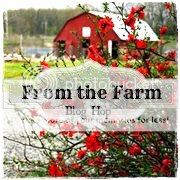A few weeks ago I wrote about my first attempts at canning/bottling tomato sauce. That post attracted so many helpful comments, thank you everyone who took the time to tell me about their canning experiences and leave me lots of links to read. The two controversial issues that came out of that post was the use of secondhand jars and lids vs. new jars and lids, and the use of open-kettle or overflow method. My first thought was that my grandmother and mother have bottled food using old jars and the overflow method for nearly 100 years, so how could it be the wrong way? But I thought I'd better do the research before I jumped to conclusions, so here's what I found out.
First the open-kettle or overflow method, in which hot food is poured into hot jars and sealed with sterilised lids, is now not a recommended method, even though it appears to still be used quite regularly. The issue with this method is that the air in the headspace has not been sterilised and may contain food-spoilage or food-poisoning micro-organisms, which could either spoil or poison the food in the jar. Obviously this does not necessarily happen every time, otherwise this method would not exist. If the food and the jar are hot enough, the headspace probably heats to sterilisation temperature, so the food remains sterile. The safer option is to boil the sealed jars in a pot of water (water bath method), for a specified amount of time, to ensure that both the contents and the headspace are sterile. This adds processing time, but guarantees are sterile product.
The problem with reusing the jars seems to be more about the potential for breakage, especially in a pressure canner. I did have one jar break when I used the overflow method, so I guess that's a risk you choose to take if you don't want to be buying new jars all the time. And its probably worse for the overflow method if you don't match the food and jar temperatures, as it will cause thermal stress in the jars and any imperfection will cause them to break. Apparently the proper canning jars are better to reuse than other jars, and maybe one set of good quality jars is an investment that will last for years.
The problem with reusing the lids is that they may not seal properly. If air can get into the jar, then micro-organisms can get in too, and the food may spoil or be poisoned. Its not the vacuum that preserves the food, but it is an indication that the lid is air-tight. New lids can be used with reclaimed jars. Its very easy to check that lids with "pop tops" are sealed, and any jars with tops that didn't suck down can be used immediately or reprocessed. New lids are more likely to seal properly, and these can be bought online. I ordered a mixed bag, as I have a few jars without lids and I thought it was worth a try.
As a side-note, I keep reading that the vacuum creates an "oxygen-free" or anaerobic environment in the jar. I don't think this is quite right, as its not an absolute vacuum (that would cause the jar to implode!), its just a relative vacuum due to the hot food and vapour cooling and condensing after the jar is sealed. This reduces the volume of the contents of the jar, which results in a slight vacuum, which sucks down the lid and creates a seal. The oxygen in the air in the headspace then most likely reacts with (oxidises) the contents of the jar until the oxygen is all consumed, and that is what would create the oxygen-free environment.
This is relevant because the worst case food poisoning potential is botulism (also wonderful infograhpic here), which is a life-threatening condition caused by a toxin produced by the bacteria Clostridium botulinum. This bacteria has spores (like seeds) that are notoriously difficult to kill, and the bacteria can grow from the spores and thrive in anaerobic conditions (without oxygen). The two ways to control growth of Clostridium botulinum is either high acid food or high temperature processing (in a pressure canner). When I read through the botulism symptoms, it made me think that it really is worth the extra effort of water bath canning rather than relying on the overflow method. Especially as mould growth can alter the pH of the food, and facilitate the growth of Clostridium botulinum, so even if you think you have high-acid food, it may not be high-acid if mould starts growing. Fortunately the botulism toxin is destroyed by heating, so if the canned food is boiled for 10-20 minutes before eating, that can remove most of the toxin, which is an extra safety precaution.
You can find some excellent canning information from the USDA on the Greenliving Australia website. And on the National Centre for Home Food Preservation website.
I hope that covers some of the issues that came out of my last post! It just makes me want to freeze, dehydrate and ferment everything instead! Did I miss anything this time??



First the open-kettle or overflow method, in which hot food is poured into hot jars and sealed with sterilised lids, is now not a recommended method, even though it appears to still be used quite regularly. The issue with this method is that the air in the headspace has not been sterilised and may contain food-spoilage or food-poisoning micro-organisms, which could either spoil or poison the food in the jar. Obviously this does not necessarily happen every time, otherwise this method would not exist. If the food and the jar are hot enough, the headspace probably heats to sterilisation temperature, so the food remains sterile. The safer option is to boil the sealed jars in a pot of water (water bath method), for a specified amount of time, to ensure that both the contents and the headspace are sterile. This adds processing time, but guarantees are sterile product.
The problem with reusing the jars seems to be more about the potential for breakage, especially in a pressure canner. I did have one jar break when I used the overflow method, so I guess that's a risk you choose to take if you don't want to be buying new jars all the time. And its probably worse for the overflow method if you don't match the food and jar temperatures, as it will cause thermal stress in the jars and any imperfection will cause them to break. Apparently the proper canning jars are better to reuse than other jars, and maybe one set of good quality jars is an investment that will last for years.
The problem with reusing the lids is that they may not seal properly. If air can get into the jar, then micro-organisms can get in too, and the food may spoil or be poisoned. Its not the vacuum that preserves the food, but it is an indication that the lid is air-tight. New lids can be used with reclaimed jars. Its very easy to check that lids with "pop tops" are sealed, and any jars with tops that didn't suck down can be used immediately or reprocessed. New lids are more likely to seal properly, and these can be bought online. I ordered a mixed bag, as I have a few jars without lids and I thought it was worth a try.
As a side-note, I keep reading that the vacuum creates an "oxygen-free" or anaerobic environment in the jar. I don't think this is quite right, as its not an absolute vacuum (that would cause the jar to implode!), its just a relative vacuum due to the hot food and vapour cooling and condensing after the jar is sealed. This reduces the volume of the contents of the jar, which results in a slight vacuum, which sucks down the lid and creates a seal. The oxygen in the air in the headspace then most likely reacts with (oxidises) the contents of the jar until the oxygen is all consumed, and that is what would create the oxygen-free environment.
This is relevant because the worst case food poisoning potential is botulism (also wonderful infograhpic here), which is a life-threatening condition caused by a toxin produced by the bacteria Clostridium botulinum. This bacteria has spores (like seeds) that are notoriously difficult to kill, and the bacteria can grow from the spores and thrive in anaerobic conditions (without oxygen). The two ways to control growth of Clostridium botulinum is either high acid food or high temperature processing (in a pressure canner). When I read through the botulism symptoms, it made me think that it really is worth the extra effort of water bath canning rather than relying on the overflow method. Especially as mould growth can alter the pH of the food, and facilitate the growth of Clostridium botulinum, so even if you think you have high-acid food, it may not be high-acid if mould starts growing. Fortunately the botulism toxin is destroyed by heating, so if the canned food is boiled for 10-20 minutes before eating, that can remove most of the toxin, which is an extra safety precaution.
You can find some excellent canning information from the USDA on the Greenliving Australia website. And on the National Centre for Home Food Preservation website.
I hope that covers some of the issues that came out of my last post! It just makes me want to freeze, dehydrate and ferment everything instead! Did I miss anything this time??




Looks like you have a good handle on it. The only lids that you can reuse are the Tattler brand. Botulism grows in a vacuum so having a bad seal should in theory just cause mold and spoilage and not botulism. The danger is that with botulism, there is a good seal and the vegetable looks good but was not heated hot enough to kill. I add vinegar to most things to put some acid in the jar, botulism doesn't like acid. A pressure caning is essential unless processing pickles or high acid fruit.
ReplyDeleteThank you for this sharing information. I made pasta sauce earlier this year, but I have been too scared to eat it after someone mentioned the same concerns to me. We did all the right things with the preparation and it looks fine. We water bathed them for extra security, but I still am worried. I guess if it doesn't develop mold,it is okay. And you mentioned that if it is heated it should be safe, that is good to know :)
ReplyDeleteThe acid in the tomatoes along with boiling it for 25 minutes will keep it safe. If you want to be really cautious then look for a pressure cooker that will hold your mason jars.
Deleteyes it sounds like you did ok Tania, just make sure you boil the sauce for 10-20 minutes before you eat it and you should be fine (as far as I know!)
DeleteHere in the US Ball and Kerr are the best known brands. I bought 3 dozen jars the first year I canned, and added a dozen or two each summer until I had plenty. I still have and use those jars 40 years later. I think they've paid for themselves many times over!D
ReplyDeleteI am into canning and researched jars a few years ago and was surprised to find that all brands in the US except the recent imports from China are owned by one company Alltrista (since renamed Jarden). So all lids and jars are now a monopoly and they charge what price they want.
Deleteoh that is disappointing Gill! No wonder they are so expensive
DeleteIf you don't reuse, then what's the point of canning in the 1st place? Jars and lids are expensive. And what do you do with the old jars and lids if you don't reuse them? Then you have to recycle. people have been reusing since they have been canning. i think we will be alright....
ReplyDeleteShe is talking about reusing jars and lids like pace salsa jars and spagetti sauce jars. Those are not safe.
Deleteyes I was talking about reusing commercial jar lids, rather than proper "canning" lids. I think if the plastic seal looks ok and they seal (suck down when they are cool), then they are ok to use and its good to reuse rather than buy new all the time.
DeleteI always love your posts... well researched. :-)
ReplyDeleteI have not heard of the overflow method before.
I primarily use water bath canning with canning jars and two-piece lids (rings and lids). I re-use the jars and rings but always use new lids because of the potential sealing issue with previously-used lids.
With meat broths I use a pressure canner, but still the same sort of jars.
We do re-use juice or jelly jars for Kombucha or temporary left-over food storage in the fridge.
thanks Kathryn! And thanks for sharing your method.
DeleteI use the water bath system; I have two good old Fowlers Vacola bottling systems with multiple reusable bottles. I have made cakes and puddings that last for a year, tomato sauce and bottled fruit like peaches and apricots (all high acid).
ReplyDeleteyou do some excellent work with that bottling system Jude, very impressive!
DeleteWell done research which encourages a rethink of our methods. If I've understood correctly it doesn't mean we can't reuse jars and when reusing lids it's best to have the pop top lids to confirm a good seal. If the seal is not confirmed the lid can be replaced and the jar reprocessed. Sounds like the best of both worlds - food safety and a reasonable level of reuse. Keep up the good work Liz.
ReplyDeleteHi John and Jean, yes that's exactly what I meant, I'm glad we agree :)
DeleteOn the question of botulism, I have been a 100 colony beekeeper for 55 years. There is a remote possibility of botulism spores being present in honey. Thus it is always recommended that babies less than one year old should only be given pasteurized honey as their stomachs are not capable of dealing with any botulism spores that may be in the honey. After one year old and older children or adults, unpasteurized honey is OK to eat as the acid and digestive juices in the stomach are strong enough to digest any botulism spores. It is not necessarily the botulism spores that are the problem, but the toxin they give out if they are allowed to grow - either in preserved food or in the stomachs of babies. Unpasteurized honey has a lot more delicate aroma than heat treated pasteurized honey, though of course if you are using the honey for cooking it doesn't make any difference.
ReplyDeletehi, thanks for explaining this, I always wondered why babies shouldn't eat honey. In an adult the botulism can't grow because we have enough stomach acid, but a baby doesn't have an acid stomach until around 1 year old.
DeleteTouchy subject and one that a lot of Americans like to get up on their soap box about. I'm all for safety and clean environments but I reuse old jars and don't bother water bathing high acid foods like jams & chutneys. There's such a low incidence of contamination, especially in Britain, that it doesn't make sense to really worry about it. Low acid foods are another matter though...
ReplyDeleteInterestingly, Botulism types, levels and locations differ based on where you are in the world. The USA has quite high levels in the soil but in Europe you'll be more likely to find it lurking in aquatic environments such as river bed sediments. This is probably one of the reasons why old fashioned preserving still prevails here.